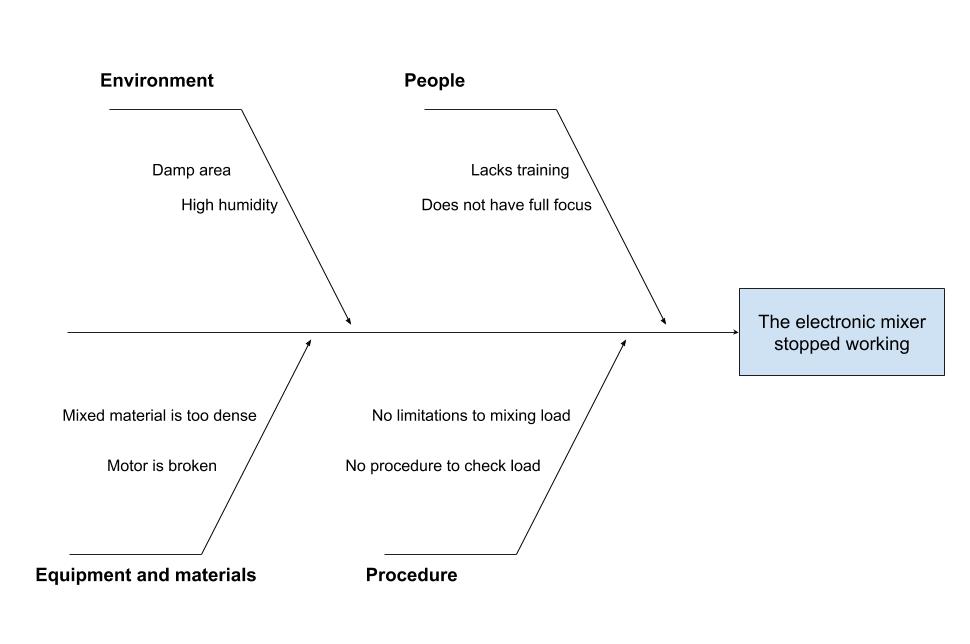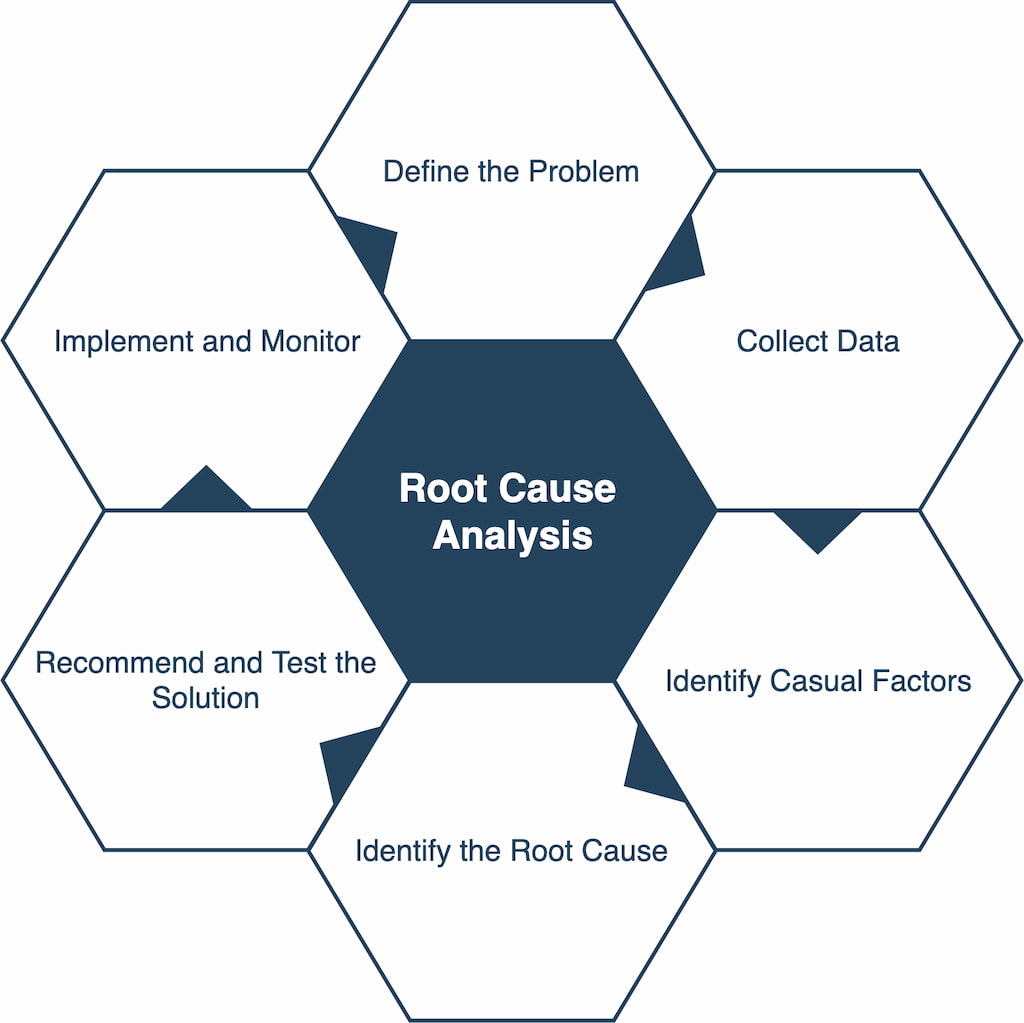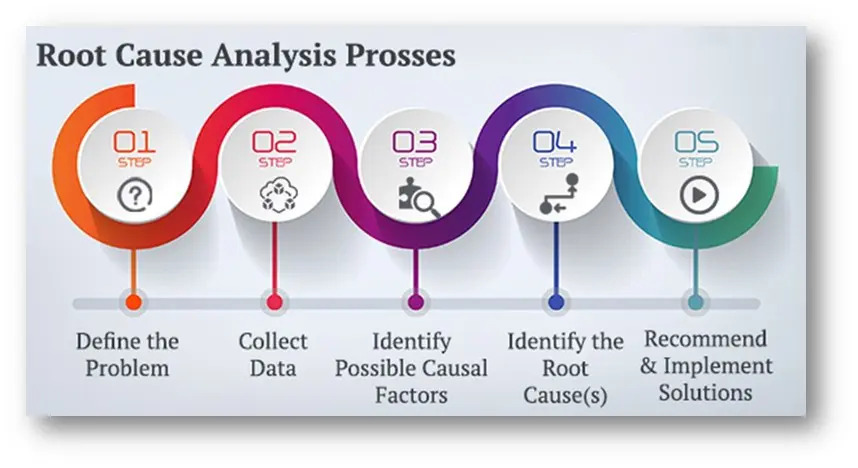The first step in any problem-solving process is to identify the problem. It’s a necessary step that cannot be bypassed even if you don’t know how to solve the problem itself. One of the most effective ways to identify the problem is to conduct a root cause analysis (which can be enhanced with tools like ClickUp time tracking). But what is a root cause analysis, exactly? In this article, we cover everything from root cause analysis to how to conduct a root cause investigation effectively.
Understanding Root Cause Analysis: The Key to Effective Problem Solving
When faced with a problem, it can be tempting to only fix the immediate issue and move on. However, if you want to get to the bottom of things and avoid future problems, you need to conduct a root-cause analysis. To even begin to understand the process, we first need to define root cause analysis.
❗ What is Root Cause Analysis?
Root cause analysis is a systematic process for finding the real source of a problem.
Once you’re able to identify the root cause, you can put measures in place to prevent similar issues in the future.
Root cause example
An example of a root cause might be an IT system failing because someone didn’t update it when they were meant to. Another example is implementing training programs, career advancement paths, and mentorship initiatives to reduce employee turnover.
Once you’ve identified the problem, you can put measures in place to prevent it from happening again—this might involve changes to processes, procedures, or training. It could also require changes to equipment or materials, depending on the nature of the issue.
✅ The Advantages of Root Cause Analysis
There are several advantages to conducting a root cause analysis. When done correctly, root cause analysis can:
🔮 Prevent future problems
Conducting a root cause analysis investigation can help organizations identify and correct the underlying causes of problems, preventing them from recurring in the future.
👨🏽🤝👨🏼 Improve team communication
Conducting root cause analysis investigations can help to improve team members’ communication and help organizations better understand their customers’ needs.

⌛ Save time and money
Root cause analyses can also save organizations time and money by preventing issues from reoccurring.
💡 Foundation for continuous improvement
Additionally, it can help organizations of all kinds build a foundation for continuous improvement by identifying opportunities for process improvements.
🤝 Promotes knowledge sharing
Finally, root cause analyses promote learning and knowledge sharing within an organization by documenting the investigation process and findings.
As long as it is done properly, conducting root cause analysis investigations will help your organization in various ways. For example, to solve problems, encourage knowledge sharing, and save your time and money which can be spent improving other parts of the business.
❌ Drawbacks of Root Cause Analysis
There are several potential challenges associated with root cause analysis. For example, root cause analysis is:
🙅♀️ Time-consuming
Root cause analysis investigations can be time-consuming and resource-intensive, especially if you’re part of a small organization with a limited budget. Investigators need to understand the problem and the systems involved in order to identify all possible causes.
🕵️♀️ Data access
RCA often requires access to data that may be difficult to obtain. If the relevant data isn’t available to the investigators, the investigation may not be able to find the root causes of an issue.
🤹♀️ Multiple factors
Another challenge with RCA is that it can be a challenge to identify the cause, often because multiple factors contribute to the issue. Additionally, changes in the system or environment can impact the results of an RCA investigation. For example, a change in the production process might eliminate a reported problem but, unfortunately, may introduce new ones.

🤷♀️ Recommendations not implementable or meaningful
Finally, RCA can sometimes lead to recommendations for changes that are difficult (or, in some cases, impossible) to implement. For example, the recommended changes may be too expensive or disruptive to implement fully, meaning the same issues may continue to occur. In other cases, investigators may not have enough information to make meaningful recommendations for change, limiting the effectiveness of a root cause analysis investigation.
Although root cause analysis has its advantages, in some cases, it may be met with roadblocks. For example, access to data, challenges identifying the cause due to lots of cause factors, and problems implementing meaningful change after the investigation closes.
Top Approaches for Conducting a Successful Root Cause Analysis
The main goal of root cause analysis is to find out the source of a problem. But there’s not just one approach—there are several approaches to root cause analysis:
The 5 Whys

The 5 Whys is a popular approach to root cause analysis. It involves asking five successive questions about a problem in order to identify its root cause. For example, if a machine is not functioning as it should, the 5 Whys approach would involve asking five successive questions such as ‘why is the machine not working?’, ‘what is causing the machine to not work?’, ‘what are the consequences of the machine not working?’, and so on. By asking these questions, it should be possible to identify root causes and take the necessary steps to fix them.
One of the key advantages of the 5 Whys approach is that it is a relatively simple way to identify the root causes of various problems. However, this specific approach may not always be successful in identifying root causes in all scenarios. For example, it may be necessary to ask more than five questions or use other approaches.
Fishbone Diagrams

Another popular root cause analysis (RCA) approach is to create a fishbone diagram. This approach helps investigation teams to visualize the relationships between different factors that may have contributed to a problem. They are also sometimes called cause and effect diagrams or Ishikawa diagrams, named after Kaoru Ishikawa, who developed this approach to root-cause analysis.
To create a fishbone diagram:
- Start by drawing a large bone shape on a piece of paper.
- Add branches coming off of the main bone, representing different factors that could have caused the problem.
- For each factor, ask why it may have contributed to the problem.
After adding a range of factors, you’ll likely soon find the source of the problem.
Fishbone diagrams have their advantages over some other root cause analysis approaches. For example, the technique is relatively straightforward, meaning it’s easy for those who’ve never encountered it before to learn how it works. On the other hand, for complex investigations, fishbone diagrams quickly become messy, and this may lead to confusion.
Change Analysis/Event Analysis

Another way to approach root cause analysis is with the change and event analysis method. Change analysis involves looking at how a system or process has changed over time, while event analysis focuses on understanding what happened during a specific incident.
Both approaches have their strengths and weaknesses but change and event analysis can be used together to get a complete picture of exactly what caused a problem. So if you’re looking to solve a problem and prevent it from happening again, this might be the best method.
Change and event analysis is a great approach because it is conceptually simple. It makes it easy for those who haven’t encountered it before to grasp. However, it can be resource-intensive compared to other approaches because the results may not be conclusive, meaning investigation teams need to conduct time-consuming testing.
Pareto Charts
A Pareto chart is a simple graphical tool that can perform root cause analysis. The charts are useful for identifying the most important factors in a given situation. Generally, they can help you prioritize actions and allocate resources effectively to save precious time and money.
To create a Pareto chart, you will first need to collect data on the different factors involved in the problem you are investigating. Once you have this data, you can create a bar chart with the different factors on the x-axis and their relative importance on the y-axis.

The most crucial factor is typically the one that contributes the most to the overall problem or issue. In most cases, this will probably be quite obvious. However, sometimes it may take time to determine which factor has caused the issue. In these cases, you can use the Pareto principle to help guide your analysis. The principle states that for most events, approximately 80% of the effects come from just 20% of the causes. This means that for many problems, most of the impact comes from a small number of contributing factors.
Applying this principle to root cause analysis will be especially useful when dealing with a complex problem with many different contributing factors, but you have limited time or resources at your disposal.
Pareto charts are favored by many because problems are ranked in severity order, meaning it’s clear to all involved which issues need tackling first. Plus, these charts often provide a more complete explanation of a problem than other root cause analysis approaches. However, Pareto charts need good data to be effective.
Failure Mode and Effect Analysis
Another potential approach is Failure Mode and Effect Analysis (FMEA), a tool used to identify possible failures in a system or process and determine the impact of those failures. You can use this approach to develop corrective actions to prevent or mitigate the effects of the failures.
FMEA is typically performed during the design phase of a project, but it can also be used after a problem has occurred to help identify the root cause. When used in an investigation, FMEA can help identify all potential causes of a problem so that they can be explored further.
Conducting an FMEA includes three steps:
1. Identify potential failure modes: What could go wrong?
2. Determine the effect of each failure mode: What would be the consequences if this happened?
3. Prioritize corrective actions based on risk: What are the chances of this happening, and how severe would the consequences be?
Conducting an FMEA ensures that all potential causes of a problem are considered during an investigation and that corrective actions are prioritized based on the level of risk involved. This is beneficial because the investigation team can fix problems based on the severity level. However, this approach might not be suitable for all root cause analysis investigations because the method is only as good as the investigation team’s. For example, problems beyond the team’s knowledge may go undetected, meaning the root cause is never identified.
❓ How to Effectively Conduct a Root Cause Investigation
To conduct an effective root cause investigation, there are a few key things to be mindful of:
1️⃣ Establish a clear problem statement
First and foremost, it is vital to establish a clear and concise root cause problem statement—this will help to ensure that the investigation stays focused and on track. A vague problem statement may cause confusion and could drag the investigation out.
2️⃣ Work in a team
When it comes to conducting root cause analysis, you shouldn’t go it alone, if possible. Whether you’re working with one other colleague or an investigation team, more people will help you spot problems, challenge assumptions and figure out workable solutions.
3️⃣ Scrutinize (and improve) the process
This probably won’t be the last time you perform root cause analysis. So when you’re conducting the investigation, make sure to identify ways that you can improve the process for next time. Do you need a larger team? Should you pursue a different root cause analysis approach? The root cause problem-solving process won’t be perfect the first time!
4️⃣ Gather data
Gather as much relevant data as possible during root cause investigations. This data can come from a variety of sources, including interviews, observations, records, and documents.
5️⃣ Verify findings
Once potential root causes have been identified, they should be verified through additional testing and analysis to ensure the investigation team has found the true problem.
6️⃣ Make findings accessible
Once you’ve successfully identified the root cause of the problem, you should make the findings available to all those who might benefit from them. Your RCA analysis might help other colleagues solve problems in the future.
You can see a variation of the process we outlined before in the picture below. Even though the steps may vary, all in all

In Summary
Root cause analysis approaches may seem complicated when encountering them for the first time, but they are practical problem-solving tools that are helpful in various situations. The key to conducting an effective root cause analysis is to work as a team, ask the right questions, and use the information you gather to improve your processes over time. By following any of the approaches outlined above, you can run an effective root cause analysis investigation and help your business or organization avoid future problems.
Boost Productivity and Efficiency with Everhour
Everhour is a highly intuitive time tracker that facilitates accurate time tracking for easy client invoicing, careful project budgeting, and painless payroll. The time tracker provides users with several valuable features, such as a handy time clock app that takes the work out of team management. Plus, Everhour offers a timesheet app, a work hours tracker, and an attendance tracker—employee time tracking and team management have never been easier!
Everhour offers two price plans. The first one is a Free plan with unlimited time tracking, projects, and reports for up to 5 users. Also, for those requiring an all-in-one solution, the Team plan, billed annually, costs $8.50 per month per user. It includes access to all integrations, extensive time management features, expense tracking, scheduling, screenshots, and much more!
In case you are managing a team of 5 or more, Everhour is the perfect tool. With seamless time tracking, you can easily estimate task durations, set clear budgets, and generate detailed reports inside Asana, Trello, Jira, or any other pm tool.


